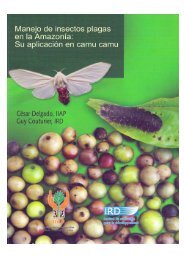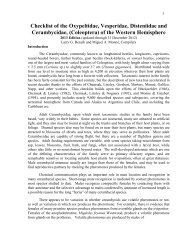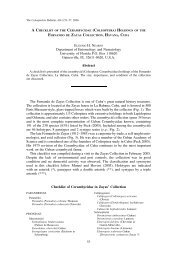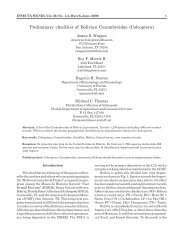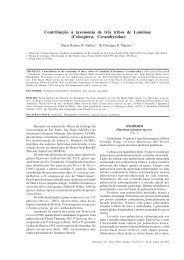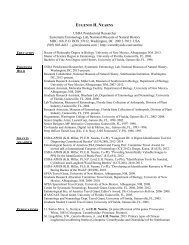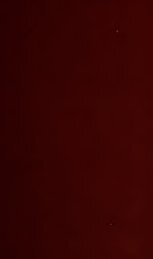Create successful ePaper yourself
Turn your PDF publications into a flip-book with our unique Google optimized e-Paper software.
LAWRENCE S. DILLON <strong>AND</strong> ELIZABETH S. DILLON 161<br />
punctures; eye with lower lobe very ovate, slighUy shorter than genal length; an<br />
tennal tubercles moderately prominent, produced internally into a very short, ro<br />
bust tooth directed upward and slightly forward. Pronotum transverse, about one<br />
fifth wider basally than at apex; a basal and apical sulcus, the apical transverse<br />
sulcus wide, only moderately deep, basal one oblique laterally; lateral tubercles<br />
feebly elevated, obtillle apically; disk with median tubercle basal and very feeble,<br />
as arc the two marc apical ones either side; base of disk and lateral tubercles with<br />
punctAtc granules. Scutellum very transverse; sides arcuate; apex very broadly<br />
rounded. Elytrll. feebly tapering to apices, which arc separately rounded; base of<br />
each elytron with a feebly raised gibbosity which is only slightly oblique; basal<br />
half with coarse, deep punctures, moderately spaced, sometimes feebly rugo..."C, be<br />
yond middle punctures becollle evanesoont to apex; humeri moderately prominent,<br />
anterior margin nearly straight, at humeral angle a very broad, obtuse tubercle.<br />
Prosternum widened behind middlej mesosternal process subtruncate at apex,<br />
feebly emarginate medially; fifth sternite about one-fourth longer than fourth, subtruncate<br />
apically. Procoxae globoso with a very broad, obtuse tubercle internally;<br />
.profemora broad basally, with only apical third clavate, basal half dorsally and<br />
ventrally rugose. Antennae about ona-third longer than body; scape reaching only<br />
to apical one-third of pronotum, robust, gradually clavate, with one deep groove<br />
and one or tlVO shallower ones internally and externally at base, remainder of surface<br />
finely, densely punctate; third segment slender, sinuate, abou two times length<br />
of seape, fourth about one-half longer than fifth, remaining segments shorter gradually;<br />
fimbriate on third, only slightly on fourth segments.<br />
FEMALE. More robust; internal production of antennal tubercles vcry obtuse ;<br />
fifth sternite at apex emargintLte, slightly fringed and triangularly impressed, about<br />
twice length of fourth ; profemora not rugose; antennae only slightly longer than<br />
body, scapi) less robust.<br />
LENGTH 12-16.5 mm.; width 4.5-6.5 mm.<br />
Type locality.-Para.<br />
Distribution.-Northern BraziL<br />
BRAZIL: 9:; no locality data; (Minn. U.]. ,2 9:; Santarem; (U.S.N.M.]. 2 ,<br />
2 9: j Santarem, October, (CM.].<br />
Hesycbotypa bimaculotu Dillon and Dillon, spec. nov.<br />
PLATE VI, FlGURl:l 8.<br />
Related to H. lit1,rata hut distinct from it in the elytra, each<br />
having a very small but distinct white macula at middle in place<br />
of the fascia; pronotum with the pale lateral vitta more pronounced,<br />
whiter, the median pale vittae coalescent behind middle<br />
to base; and the antennae short, just about as long as body.<br />
FEMALE. Elongate-ovate, rather slender, above sulxiepressed; fuseous, densely<br />
brown pubescent, variegated with dull orange and hoary. Head above orange and



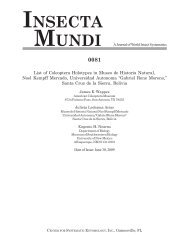
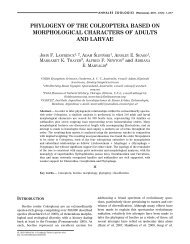


![Coleoptera. Vol. I. [Longicornia. Part I.]](https://img.yumpu.com/41202793/1/180x260/coleoptera-vol-i-longicornia-part-i.jpg?quality=85)
